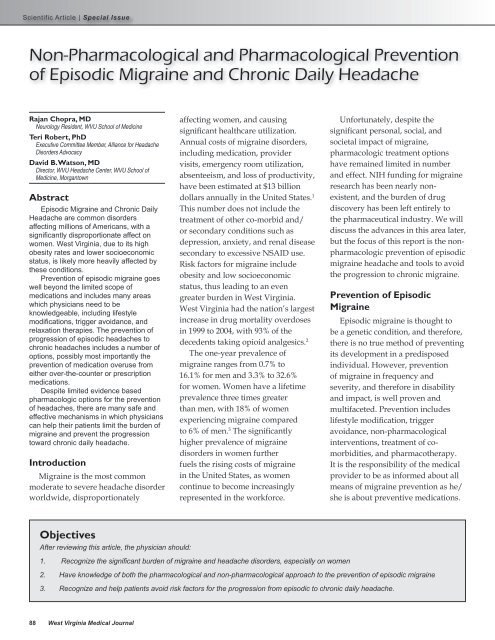Special CME Issue - West Virginia State Medical Association
Special CME Issue - West Virginia State Medical Association
Special CME Issue - West Virginia State Medical Association
Create successful ePaper yourself
Turn your PDF publications into a flip-book with our unique Google optimized e-Paper software.
Non-Pharmacological and Pharmacological Prevention<br />
of Episodic Migraine and Chronic Daily Headache<br />
Rajan Chopra, MD<br />
Neurology Resident, WVU School of Medicine<br />
Teri Robert, PhD<br />
Executive Committee Member, Alliance for Headache<br />
Disorders Advocacy<br />
David B. Watson, MD<br />
Director, WVU Headache Center, WVU School of<br />
Medicine, Morgantown<br />
Abstract<br />
Episodic Migraine and Chronic Daily<br />
Headache are common disorders<br />
affecting millions of Americans, with a<br />
significantly disproportionate affect on<br />
women. <strong>West</strong> <strong>Virginia</strong>, due to its high<br />
obesity rates and lower socioeconomic<br />
status, is likely more heavily affected by<br />
these conditions.<br />
Prevention of episodic migraine goes<br />
well beyond the limited scope of<br />
medications and includes many areas<br />
which physicians need to be<br />
knowledgeable, including lifestyle<br />
modifications, trigger avoidance, and<br />
relaxation therapies. The prevention of<br />
progression of episodic headaches to<br />
chronic headaches includes a number of<br />
options, possibly most importantly the<br />
prevention of medication overuse from<br />
either over-the-counter or prescription<br />
medications.<br />
Despite limited evidence based<br />
pharmacologic options for the prevention<br />
of headaches, there are many safe and<br />
effective mechanisms in which physicians<br />
can help their patients limit the burden of<br />
migraine and prevent the progression<br />
toward chronic daily headache.<br />
Introduction<br />
Migraine is the most common<br />
moderate to severe headache disorder<br />
worldwide, disproportionately<br />
affecting women, and causing<br />
significant healthcare utilization.<br />
Annual costs of migraine disorders,<br />
including medication, provider<br />
visits, emergency room utilization,<br />
absenteeism, and loss of productivity,<br />
have been estimated at $13 billion<br />
dollars annually in the United <strong>State</strong>s. 1<br />
This number does not include the<br />
treatment of other co-morbid and/<br />
or secondary conditions such as<br />
depression, anxiety, and renal disease<br />
secondary to excessive NSAID use.<br />
Risk factors for migraine include<br />
obesity and low socioeconomic<br />
status, thus leading to an even<br />
greater burden in <strong>West</strong> <strong>Virginia</strong>.<br />
<strong>West</strong> <strong>Virginia</strong> had the nation’s largest<br />
increase in drug mortality overdoses<br />
in 1999 to 2004, with 93% of the<br />
decedents taking opioid analgesics. 2<br />
The one-year prevalence of<br />
migraine ranges from 0.7% to<br />
16.1% for men and 3.3% to 32.6%<br />
for women. Women have a lifetime<br />
prevalence three times greater<br />
than men, with 18% of women<br />
experiencing migraine compared<br />
to 6% of men. 3 The significantly<br />
higher prevalence of migraine<br />
disorders in women further<br />
fuels the rising costs of migraine<br />
in the United <strong>State</strong>s, as women<br />
continue to become increasingly<br />
represented in the workforce.<br />
Unfortunately, despite the<br />
significant personal, social, and<br />
societal impact of migraine,<br />
pharmacologic treatment options<br />
have remained limited in number<br />
and effect. NIH funding for migraine<br />
research has been nearly nonexistent,<br />
and the burden of drug<br />
discovery has been left entirely to<br />
the pharmaceutical industry. We will<br />
discuss the advances in this area later,<br />
but the focus of this report is the nonpharmacologic<br />
prevention of episodic<br />
migraine headache and tools to avoid<br />
the progression to chronic migraine.<br />
Prevention of Episodic<br />
Migraine<br />
Episodic migraine is thought to<br />
be a genetic condition, and therefore,<br />
there is no true method of preventing<br />
its development in a predisposed<br />
individual. However, prevention<br />
of migraine in frequency and<br />
severity, and therefore in disability<br />
and impact, is well proven and<br />
multifaceted. Prevention includes<br />
lifestyle modification, trigger<br />
avoidance, non-pharmacological<br />
interventions, treatment of comorbidities,<br />
and pharmacotherapy.<br />
It is the responsibility of the medical<br />
provider to be as informed about all<br />
means of migraine prevention as he/<br />
she is about preventive medications.<br />
Objectives<br />
After reviewing this article, the physician should:<br />
1. Recognize the significant burden of migraine and headache disorders, especially on women<br />
2. Have knowledge of both the pharmacological and non-pharmacological approach to the prevention of episodic migraine<br />
3. Recognize and help patients avoid risk factors for the progression from episodic to chronic daily headache.<br />
88 <strong>West</strong> <strong>Virginia</strong> <strong>Medical</strong> Journal















